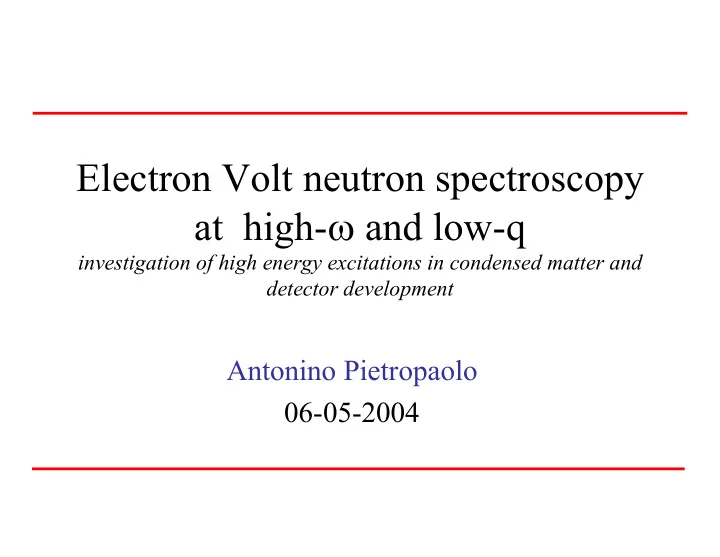

Electron Volt neutron spectroscopy at high- ω and low-q investigation of high energy excitations in condensed matter and detector development Antonino Pietropaolo 06-05-2004
OUTLINE • Physical context • Kinematical constraints • Instrumentation development • Some preliminary results • Future perspectives • Conclusions
Physical context • High energy excitations in condensed matter – Electronic structures in rare earths systems – Band structures of insulators and semiconductors – Magnetic properties of superconductors – High energy vibrational states in molecular and H-metal systems
Electronic structures in atoms and compounds • Electronic structure of many electron atoms is described by different models: – Central field approximation-CFA (periodicity of the chemical properties) – Thomas Fermi (statistical-semi-classsical calculations) – Harthree-Fock (variational method) – Corrections to the CFA ( L-S coupling) – Fine structure and multiplet splitting – Crystal field effects
Rare earths systems High energy excitation in Praseodymium A.D.Taylor, et al, PRL 61/11 (1988), 1309 . Density of states of δ -Plutonium Seraching for the � 1.2 eV transition
Insulators and semiconductors One important example investigation of the diamond band structure
Superconductors High-energy magnetic excitations in URu 2 Si 2 some magnetic properties of the SC (e.g. magnetic phase transitions) can be understood in terms of electronic configuration
the neutron probe • Neutron has a large magnetic dipole moment µ = − µ 1.913 Magnetic dipole moment n N − µ = × 27 JT -1 5.051 10 Nuclear magneton N r s • It interacts with the unpaired electron spin • Inelastic magnetic scattering with q > 0
cross sections final energy 1 σ E d ) ( 2 ) ( = f µ ν δ ω − − 2 r G Q ; , E E h µ ν 0 Ω dE d E f i energy eigenvalues of wave vector transfer the electronic quantum initial energy states µ >, ν > 0.29 b (classical electron radius) 2 E i -E f (energy transfer) Magnetic form factor
Investigating the Form factors Q- dependence of G(Q) Sm Pr
Molecular systems • High-lying vibrational states in molecular systems (e.g. O-H stretching mode in H 2 O) • Extrapolation of the vibrational density of states 2 E = G Q E ( , ) S Q E ( , ) 2 Q
Further examples H in metal matrix Higher harmonics in the vibrational spectrum give information on the possible ahnarmonicity of the H single particle potential in a metal (H-metal force)
Kinematical constraints ħ ω = 1.5 eV Q [ Å -1 ]
Kinematical constraints E f = 72.0 eV (Lantanum) HIGH ENERGY NEUTRONS HAVE TO BE DETECTED AT SMALL ANGLES E f = 6.671 eV (Uranium)
The ISIS pulsed source LINAC Sinchrotron Target station Experimental halls 800 MeV protons ISIS II
Instrumentation development • Effective neutron detection systems for eV neutrons – Standard 6 Li- or 3 He-based neutron counters show a 1/v behaviour for neutron absorption efficiency – Not effective above 20 eV • Dedicated instrumentation – Spectrometers
The e.VERDI instrument - FSD BANK : proton dynamics RFS or RDS ? - VLAD : high energy excitations RDS Vesuvio: V L A D: n
Two possible configurations RFS RDS
A closer look at the RDS set up p target “start” Solid state (CZT) n γ detector “stop” X Fast n’ DAE Electronic chain γ sample Analyser foil TOF (n, γ ) reactions spectra Scintillator (YAP)
exploring unexplored regions of the (Q, ω ) space VLAD
Some preliminary results • DINS measurements on water with RDS : Measuring <E k > and n(p) 1 eV � ω � 10 eV 35 Å -1 � q � 70 Å -1 good agreement with standard RFS measurements
VLAD results • HINS measurements on a ice sample on VLAD prototype E ∫ ω ω = 2 ± 2 atoms/cell E g ( ) d 9 2.5 Å -1 � q � 5.5 Å -1 1 Andreani et al. Appl. Phys. Lett submitted for publication Previous measurements on HRMECS at IPNS Argonne National Laboratory E ∫ 2 ω ω = ± 0.1 atoms/cell E g ( ) d 8 q � 7 Å -1 1 Andreani et al. J. Chem Phys. 83, 750 (1985)
Future perspectives • Physics: – Measurements on rare earth systems ( e.g. Praseodymium) – Measurements on diamond (band structure investigation) • Technology: – Improvement of ω resolution – Improvement of q resolution – R&D on neutron detectors
Conclusions � The investigation of electronics structures of complex systems (rare earths metals and compounds, semicondctors, insulators, superconductors) and the high-lying vibrational states in molecules and metal-H systems are interesting physical topics. � High- ω coupled to low-q measurements are needed due to the kinematical constraints � Neutrons well above 1 eV have to be detected at small angles, so…. � New and effective detection techniques/instrumentation have to be developed/designed � Test measurements on both VESUVIO and VLAD show that RDS configuration is an effective configuration both for DINS and HINS � e.VERDI instrument: FSD and VLAD bank for DINS and HINS … � There is a lot of interesting work to be done !
Recommend
More recommend